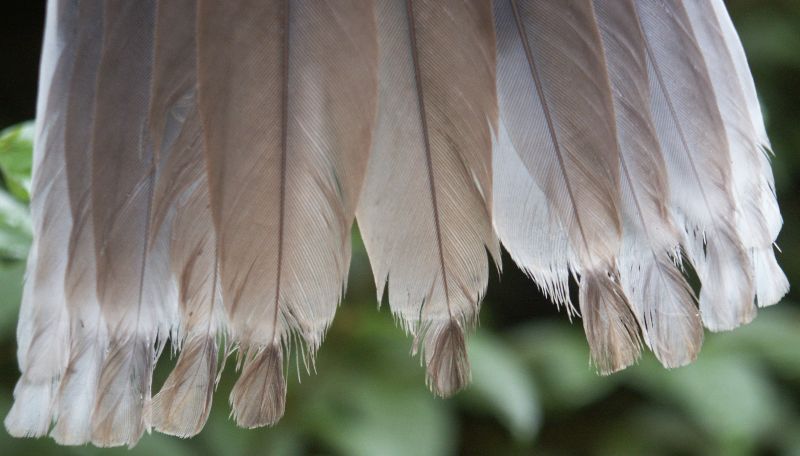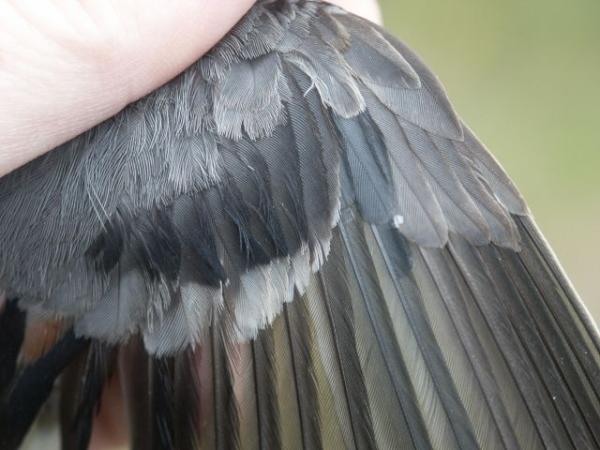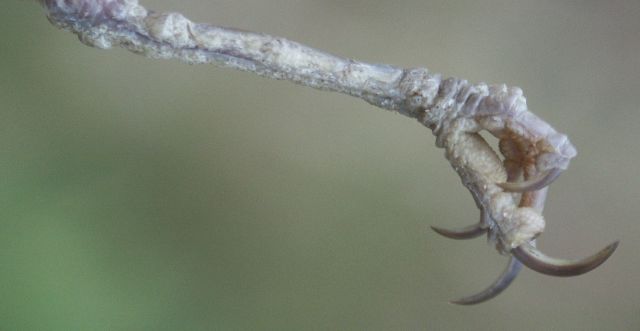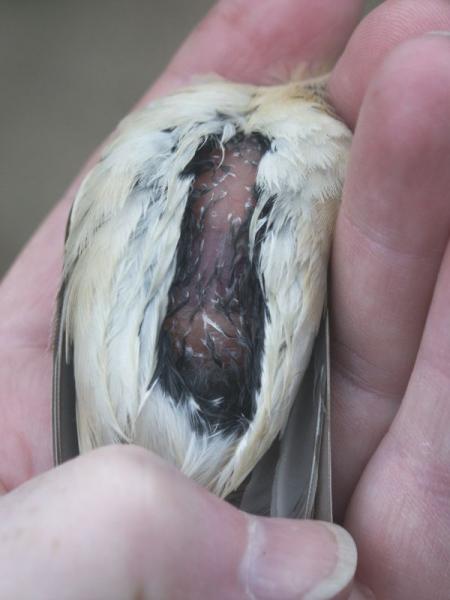Odds and ends (20 August 2003)
I have written before on the theme of eye colours. Having a net up in my garden last week allowed me to catch three Collared Doves Streptopelia decaocto, all first-year birds (Euring age code = 3). The photo below shows the eyes of these three birds, with an adult (age 4) that I photographed in February for comparison. The brownish colours of the juveniles and the reddish hue of the adult are quite easy to distinguish once you get your eye in (!). I think this can be a particularly helpful extra ageing characteristic in this species where both first-years and adults have a full moult.

One of these birds had a very obvious fault-bar across the tail. We can have interesting, but largely nugatory, discussions about when a growth-bar becomes a fault-bar, but in this case I don't think there is much doubt:

Starlings Sturnus vulgaris are another of the species where juveniles have a complete moult, although they can still be aged after the moult by subtle differences in plumage such as the shape of uppertail coverts and the length of the throat feathers. The juvenile and 'adult' feathers are so different in colour that it must be about the easiest species in which to detect 'new' and 'old' feathers. They're almost like the brightly-coloured pictures (red, yellow, green, blue) that Jenni & Winkler use to illustrate the schematics of moult progress. This photo shows two pictures of the same bird caught in my garden on 11 August:

Using the standard scoring system of 0=old feather to 5=fully-grown new feather, I would score the remiges as 5 3 5 | 0 0 0 0 1 4 | 5 5 5 5 5 4 2 0 0 0. The tertials are the most exposed feathers and are moulted early, along with some of the innermost primaries. Although they are probably only about ten weeks old, the wear on the tips of p8 and p9 (counting descendantly) is noticeable, with p8 having broken, so the need for a full moult is perhaps obvious. I think the coverts are interesting and instructive. Each primary covert is moulted along with the corresponding primary feather, so that the outer primary coverts are still juvenile pale-brown. On the other hand, it has moulted all of its greater (secondary) coverts in one go as a block, not linked with the corresponding secondaries. I have not photographed the upper parts of the wing (under my thumb) very well, but it can also be seen that the lesser coverts are growing, and the small feather of the alula (sometimes called A1 or the alula covert), but not yet the median coverts and the larger two alula feathers (A2 and A3).
Now that we've looked at an easy one, a male Bullfinch Pyrrhula pyrrhula yesterday had three generations of coverts. It was aged '5', hatched 2002, now in full moult for the first time.

This close-up of its coverts shows its oldest feathers - those that it came out of the nest with: the outer primary coverts, alula (note the brown fringe on the smallest alula feather) and the two outermost greater coverts. The next generation, that it grew last autumn in its post-juvenile moult are the rest of the greater coverts and, unusually, its carpal covert that has a greyish border rather than the brownish that is usual for a bird aged 5. Jenni & Winkler had one bird out of their sample of 229 that had moulted a carpal covert (on one wing only) and a 1980 article in Ringers' Bulletin on ageing Bullfinches noted three out of several hundred 1y birds that had moulted the carpal covert, two of them with some ogcs retained. So this bird is decidedly unusual but not unprecedented and shows the importance of looking closely at birds: a quick glance at the greyish carpal coverts would have put it down as age 6. The third generation of feathers is the innermost three primary coverts, just recently grown along with the corresponding primaries as it undergoes its full moult.
I also photographed a Sedge Warbler Acrocephalus schoenobaenus, a nicely worn adult and might be the last that we see this year - 90% or more of the adults have gone by now - but also it had diseased legs, although not so badly affected as to make it unringable.

Lastly, as a reminder that most of our warblers are heading off, an adult (age 5) male Reed Warbler Acrocephalus scirpaceus, first ringed on 16 July and retrapped on 22 July, was caught again with a heavy load of fat - 6 on the ESF 8-point scale, a level seldom seen in Britain. On the July dates it weighed 13.3 and 13.4 g, already quite heavy for a Reed Warbler (base weight is ~10.5 g) but yesterday it was up to 15.6 g. This is enough fuel to get it to Portugal, or north Africa, in one go. The photograph below is an unusual, and ungainly, look at this bird: its head is uppermost, between my fingers, and I have moistened the belly feathers to part them to show the fat. The subcutaneous fat is the yellow stuff bulging out of the tracheal pit and the lower belly onto the abdomen; the abdomen still is visible as the bright red skin colour.

David Norman.